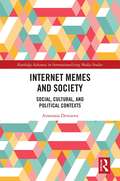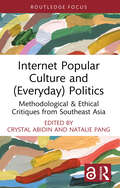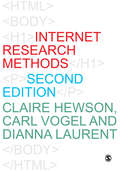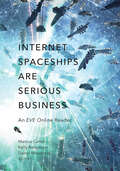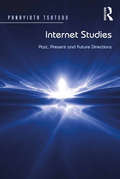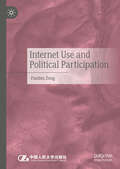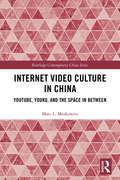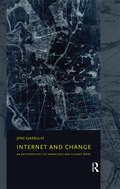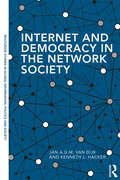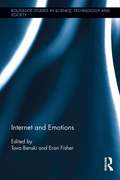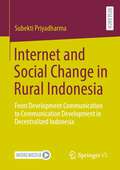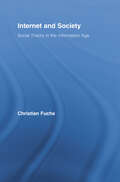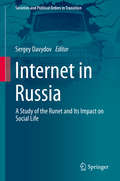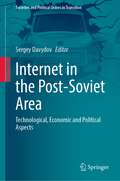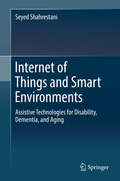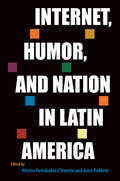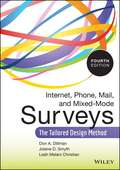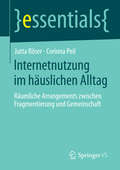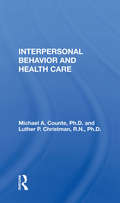- Table View
- List View
Internet Memes and Society: Social, Cultural, and Political Contexts (Routledge Advances in Internationalizing Media Studies)
by Anastasia BertazzoliThis book provides a solid, encompassing definition of Internet memes, exploring both the common features of memes around the globe and their particular regional traits. It identifies and explains the roles that these viral texts play in Internet communication: cultural, social and political implications; significance for self-representation and identity formation; promotion of alternative opinion or trending interpretation; and subversive and resistant power in relation to professional media, propaganda, and traditional and digital political campaigning. It also offers unique comparative case studies of Internet memes in Russia and the United States.
Internet Newspapers: The Making of a Mainstream Medium (Routledge Communication Series)
by Xigen LiInternet Newspapers: The Making of a Mainstream Medium examines newspapers on the Internet, and addresses the emergence of online newspapers and the delivery of news through this outlet. Utilizing empirical research, chapters explore the theoretical and practical issues associated with Internet newspapers and examine the process through which online newspapers have grown into a mainstream medium. Contributions to this work emphasize three key areas: the structure and presentation of newspapers on the Internet; the medium as an interactive process; and the ways in which the public interacts with Internet newspapers.This collection makes a substantial contribution to the understanding of newspapers on the Internet, covering their development and changes as well as the impact that news delivery through this medium has had on other media, audiences, and society. It also sheds light on improving operation and performance of Internet newspapers to better serve the public and gain competitive knowledge. The volume encourages additional scholarship in this area, and also shows how researchers can benefit from an empirical approach to their examination of Internet newspapers.Internet Newspapers will appeal to scholars, researchers, and students of journalism and mass communications, and can be used as a supplementary text in advanced courses covering journalism, communication technology, and mass media and society.
Internet Philanthropy in China
by Yidan ChenThis book is the work of Charles Chen Yidan, “the Father of China’s Internet Philanthropy”. It is based on the long-term research and practices of Tencent Research Institute and the Tencent Foundation. It reviews the recent history of internet-based charity during the past 20 years. It provides a first-time comprehensive review and study of internet-based charity from different dimensions, including the nature of internet-based charity, typical innovations and practices at home and abroad, as well as future prospects for integrating new technology and charity. It offers important insights into the transformation of many charitable organizations, the regulatory approach of governments towards these organizations, and the development of future society. This book contains not only a large set of the latest data from foreign countries but also exclusive interviews of many industry experts, including the directors of online charity platforms and chairmen of typical charitable organizations. It provides valuable references and is highly recommended for enterprises, organizations, and authorities that want to understand and promote the advancement of philanthropy in China.
Internet Popular Culture and (Everyday) Politics: Methodological & Ethical Critiques from Southeast Asia
by Crystal Abidin Natalie PangThis edited collection considers how scholars conduct research on (everyday) politics in Southeast Asia via networks of internet popular culture. This includes artefacts, networks, groups, and cultures that are specific to Southeast Asian online practices, and that seek to represent, advocate for, provoke, or question how citizens "do" politics online.In the Southeast Asia region in particular, these behind-the-scenes minutiae of everyday decisions are all the more under-valued when researchers have been taught, conditioned, or cautioned to tiptoe around taboo or political topics implicitly policed by states and governments. The combination of media regimes with limited press freedoms, the employment of sedition acts against citizens, and the need to be strategic to secure state and industry funding for research have pressured or motivated scholars to strategically obscure certain research anecdotes in favour of a smoother publishing journey and/or posterity. As such, this collection serves as a sounding board and collection of reflections on what it really looks like to conduct research on everyday politics online in the Southeast Asian region, while navigating innovative media methods, negotiating inter-disciplinary gatekeeping, demands of publishing in tiered journals, and the tensions around legitimising one's methodological choices. This collection features four accounts of scholars contemplating the methodological and ethical conundrums when conducting research on Southeast Asian internet popular culture and everyday politics.This book will be useful for the readers in the disciplines of anthropology, Asian studies, communications, cultural studies, media studies, and science and technology studies.
Internet Research Methods
by Carl Vogel Claire Hewson Dianna LaurentThe internet is a compelling tool for research, enabling efficient, cost-effective data collection and facilitating access to large samples and new populations. This book presents a state-of-the-art guide to the internet as a tool for conducting research in the social and behavioural sciences using qualitative, quantitative and mixed methods approaches. New to this edition: Fully re-written to reflect the emergence of Web 2.0 technologies Expanded coverage of web surveys for data collection Unobtrusive methods to harvest data from online archives and documents New practical tools and resources, where to find them, and how to keep up-to-date with new developments as they emerge New chapter on research ethics and discussion of ethical practicalities throughout Guiding the reader through the theoretical, ethical and practical issues of using the internet in research, this is an essential resource for researchers wishing to assess how the latest techniques, tools and methods in internet-mediated research may support and expand research in their own field.
Internet Research Methods
by Carl Vogel Claire Hewson Dianna LaurentThe internet is a compelling tool for research, enabling efficient, cost-effective data collection and facilitating access to large samples and new populations. This book presents a state-of-the-art guide to the internet as a tool for conducting research in the social and behavioural sciences using qualitative, quantitative and mixed methods approaches. New to this edition: Fully re-written to reflect the emergence of Web 2.0 technologies Expanded coverage of web surveys for data collection Unobtrusive methods to harvest data from online archives and documents New practical tools and resources, where to find them, and how to keep up-to-date with new developments as they emerge New chapter on research ethics and discussion of ethical practicalities throughout Guiding the reader through the theoretical, ethical and practical issues of using the internet in research, this is an essential resource for researchers wishing to assess how the latest techniques, tools and methods in internet-mediated research may support and expand research in their own field.
Internet Spaceships Are Serious Business: An EVE Online Reader
by Marcus Carter Kelly Bergstrom Darryl WoodfordEVE Online is a socially complex, science-fiction-themed universe simulation and massively multiplayer online game (MMOG) first released in 2003. Notorious for its colossal battles and ruthless player culture, it has hundreds of thousands of players today. In this fascinating book, scholars, players, and EVE&’s developer (CCP Games) examine the intricate world of EVEOnline--providing authentic accounts of lived experience within a game with more than a decade of history and millions of &“real&” dollars behind it.Internet Spaceships Are Serious Business features contributions from outstanding EVE Online players, such as The Mittani, an infamous member of the game&’s community, as well as academics from around the globe. They cover a wide range of subjects: the game&’s technicalities and its difficulty; its projection of humanity&’s future in space; the configuration of its unique, single-server game world; the global nature of warfare in its &“nullsec&” territory (and how EVE players have formed a global concept of time); stereotypes of Russian players; espionage play; in-game memorials to Vile Rat (aka U.S. State Department official Sean Smith, murdered in the 2012 Benghazi attack); its gendered playing experience; and CCP Games&’ relationship with players; and its history and legacy.Internet Spaceships Are Serious Business is a must for EVE Online players interested in a broad perspective on their all-consuming game. It is also accessible to scholars, game designers seeking to understand and replicate the successful aspects unique to EVE Online, and even those who have never played this notoriously complex game.Contributors: William Sims Bainbridge, National Science Foundation; Chribba; Jedrzej Czarnota; Kjartan Pierre Emilsson; Dan Erdman; Rebecca Fraimow; Martin R. Gibbs, U of Melbourne; Catherine Goodfellow; Kathryn Gronsbell; Keith Harrison; Kristin MacDonough; Mantou (Zhang Yuzhou); Oskar Milik; The Mittani (Alexander Gianturco); Joji Mori; Richard Page; Christopher Paul, Seattle U; Erica Titkemeyer, U of North Carolina at Chapel Hill; Nick Webber, Birmingham City U.
Internet Studies: Past, Present and Future Directions
by Panayiota TsatsouThis book considers the lessons learnt so far from the emergence of the Internet and the development of the field of Internet studies, whilst also considering possible directions for the future. Examining broad media theories and emerging theorisations around the Internet specifically, it explores the possibility of the development of an Internet theory in the future. A comprehensive overview of the field, Internet Studies considers key issues of social importance that the study of the Internet draws upon, such as the role of the Internet in civic participation and democratisation, the development of virtual communities, digital divides and social inequality, as well as Internet governance and policy control. At the same time, it examines the role of the Internet in social research and the development of highly interdisciplinary and rapidly developing Internet research. Hence, this volume maps key areas of certainty and uncertainty in the field of Internet studies and, as such, it will be of interest to scholars and students of media and communication, sociology and social research methods.
Internet Use and Political Participation
by Fanbin ZengThis book explores how Chinese citizens influence both real and internet political participation via using internet. During real political participation in selection and collective incident, the influence of internet use is different, which results from different situations of the development of different types of political participation in China. According to the analysis on the political participation in the network public opinion&’s supervision, internet advice, and internet alternative, the author finds that these types of political participation subject to institutional arrangement and effect of real political participation. Therefore, the author proposes that the real political participation effected by the use of internet and internet political participation mutually supply and influence each other, where there is inverse relationship between them. This book will be of interest to researchers, political scientists, and media studies scholars.
Internet Video Culture in China: YouTube, Youku, and the Space in Between (Routledge Contemporary China Series)
by Marc L MoskowitzExamining Internet culture in the People’s Republic of China, Taiwan, Hong Kong, and the US, this book analyzes videos which entertain both English and Chinese-speaking viewers to gain a better understanding of cultural similarities and differences. Each of the chapters in the volume studies streaming videos from YouTube and its Chinese counterparts, Todou and Youku, with the book using a combination of interpretative analysis of content, commentary, and ethnographic interviews. Employing a diverse range of examples, from Michael Jackson musical mash-ups of Cultural Revolution visuals, to short clips of Hitler ranting about twenty-first century issues with Chinese subtitles, this book goes on to explore the ways in which traditional beliefs regarding gender, romance, religion, and politics intersect. Looking at how these issues have changed over the years in response to new technologies and political economies, it also demonstrates how they engage in regional, transnational, and global dialogues. Comparing and incorporating the production of videos with traditional media, such as television and cinema, Internet Video Culture in China will be useful to students and scholars of Internet and digital anthropology, as well as Cultural Studies and Chinese Studies more generally.
Internet and Change: An Ethnography of Knowledge and Flexible Work (Intervention Press Ser.)
by Jens KjaerulffIn the lively debate over how Internet creates social and cultural change, the concept of change itself has not been well understood. Through an ethnographic exploration of telework and fine-grained descriptions of the material experience of Internet use, this book makes an important contribution to the theory of cultural change and the social analysis of technology. Kjaerulff argues that telework is mostly practiced informally, and that this form of flexible work is more prevalent than commonly assumed. Against conventional assertions that flexible work promotes alienation, he shows that the picture is far more complex and that the cultural conception ofwork changes through new practices of economic behavior.
Internet and Democracy in the Network Society (Routledge Studies in Global Information, Politics and Society)
by Kenneth L. Hacker Jan A.G.M. van DijkA seminal shift has taken place in the relationship between Internet usage and politics. At the turn of the century, it was presumed that digital communication would produce many positive political effects like improvements to political information retrieval, support for public debate and community formation or even enhancements in citizen participation in political decision-making. While there have been positive effects, negative effects have also occurred including fake news and other political disinformation, social media appropriation by terrorists and extremists, ‘echo-chambers’ and "filter bubbles", elections influenced by hostile hackers and campaign manipulation by micro-targeting marketing. It is time for critical re-evaluation. Designed to encourage critical thinking on the part of the student, internationally recognized experts, Jan A.G.M. van Dijk and Kenneth Hacker, chronicle the political significance of new communication technologies for the promotion of democracy over the last two decades. Drawing upon structuration theory and network theory and real-world case studies from across the globe, the book is logically structured around the following topics: Political Participation and Inclusion Habermas and the Reconstruction of Public Space Media and Democracy in Authoritarian States Democracy and the Internet in China E-government and democracy Views of democracy and Internet use Underpinned by up-to-date literature, this important textbook is aimed at students and scholars of communication studies, political science, sociology, political communication, and international relations.
Internet and Emotions (Routledge Studies in Science, Technology and Society #22)
by Tova Benski and Eran FisherNothing seems more far removed from the visceral, bodily experience of emotions than the cold, rational technology of the Internet. But as this collection shows, the internet and emotions intersect in interesting and surprising ways. Internet and Emotions is the fruit of an interdisciplinary collaboration of scholars from the sociology of emotions and communication and media studies. It features theoretical and empirical chapters from international researchers who investigate a wide range of issues concerning the sociology of emotions in the context of new media. The book fills a substantial gap in the social research of digital technology, and examines whether the internet invokes emotional states differently from other media and unmediated situations, how emotions are mobilized and internalized into online practices, and how the social definitions of emotions are changing with the emergence of the internet. It explores a wide range of behaviors and emotions from love to mourning, anger, resentment and sadness. What happens to our emotional life in a mediated, disembodied environment, without the bodily element of physical co-presence to set off emotional exchanges? Are there qualitatively new kinds of emotional exchanges taking place on the internet? These are only some of the questions explored in the chapters of this book, with quite surprising answers.
Internet and Social Change in Rural Indonesia: From Development Communication to Communication Development in Decentralized Indonesia
by Subekti PriyadharmaThis book is based on an empirical research which explores bottom-up development practices initiated and organized by rural communities in the Indonesian periphery by placing “communication” at its core of analysis. The aim is to determine the extent that the Indonesian decentralization policy and the use of internet and other digital Information and Communication Technologies (ICTs) has affected the theory and practice of development communication as well as changes in relations between the center and the periphery within the context of Indonesian rural development. The book takes on periphery perspective in center-periphery interactions and relations. Hence, it belongs to "periphery research" that has rarely been used in recent decades. By using Grounded Theory for its data collection and analysis method, the results of this study are grouped into two major thematic categories: “communication development”, instead of development communication, and “communication empowerment”.
Internet and Society: Social Theory in the Information Age (Routledge Research in Information Technology and Society)
by Christian FuchsIn this exceptional study, Christian Fuchs discusses how the internet has transformed the lives of human beings and social relationships in contemporary society. By outlining a social theory of the internet and the information society, he demonstrates how the ecological, economic, political, and cultural systems of contemporary society have been transformed by new ICTs. Fuchs highlights how new forms of cooperation and competition are advanced and supported by the internet in subsystems of society and also discusses opportunities and risks of the information society.
Internet in Russia: A Study of the Runet and Its Impact on Social Life (Societies and Political Orders in Transition)
by Sergey DavydovThis book presents an interdisciplinary analysis of the Internet in Russia and its impact on various aspects of social life. The contributions discuss topics such as the features of the Russian media system and digitization processes, the history of the Runet, national Internet markets and the Internet economy, as well as legal aspects. By presenting the results of relevant case studies, it illustrates the process of integrating the Russian segment of the Internet into the international system, offering insights into various country-specific features of the Runet’s functioning and development.The first part of the book focuses on the Internet in the context of development of the Russian media system with respect to historical features and digital inequalities. The second part then discusses economic and legal aspects of the Runet, while the third and the fourth parts offer an analysis of digital culture, including the role of journalism and regional diversities as well as online representations and discussions. The chapter "Runet in Crisis Situations" is available open access under a CC BY 4.0 license at link.springer.com.
Internet in the Post-Soviet Area: Technological, Economic and Political Aspects (Societies and Political Orders in Transition)
by Sergey DavydovThis book offers a comparative perspective on the technological, economic, and political aspects of Internet development in the post-Soviet countries. In doing so, international experts analyze similarities and differences in various countries throughout the chapters.The volume consists of two parts. The chapters of the first part examine the post-Soviet area as a whole. The second part includes specific case studies on the development of the Internet, either in individual countries or in groups of countries. Countries analyzed are Estonia, Ukraine, Russia as well as three Central Asian countries: Kazakhstan, Uzbekistan and Tajikistan. Topics covered in the volume include, but are not limited to measurement, dynamics, and structure of each national Internet audience; the history of the Internet in the post-Soviet countries; development of infrastructure; Internet regulation and institutional aspects; online markets such as telecommunications, online advertising, e-commerce, and digital content; social and cultural aspects; as well as the transformation of the national media systems. This book is a must-read for students, researchers, and scholars of political science and economics, as well as policymakers and practitioners interested in a better understanding of Internet development in the post-Soviet area.
Internet of Things (IoT) Enabled Automation in Agriculture
by Rajesh Singh Sushabhan Choudhury Anita Gehlot Bhupendra SinghThis book provides basic knowledge of the programming and interfacing of devices with IoT modem and programming. The aim is to explain the basic steps to understand the IoT and its application in agriculture field. It will serve be a reference book for postgraduate and undergraduate Engineering students. Students from Electronics, Electrical, Mechatronics, Robotics, Mechanical, Computer science can use the book for their projects and research. This book is based entirely on the practical experience of the authors while undergoing projects with the students and industries. This book is co-published with NIPA. Taylor and Francis does not sell or distribute its print and electronic editions in India, Pakistan, Nepal, Bhutan, Bangladesh and Sri Lanka.
Internet of Things and Smart Environments
by Seyed ShahrestaniThis book is focused on the Internet of Things (IoT) services and smart environments that can be of assistance to the elderly and individuals living with dementia or some sensory impairment. The book outlines the requirements of the systems that aim to furnish some digital sensory or cognitive assistance to the individuals and their caregivers. Internet of Things and Smart Environments: Assistive Technologies for Disability, Dementia, and Aging covers the important evolutions of the IoT, the sensors, actuators, wireless communication and pervasive computing systems, and other enabling technologies that power up this megatrend infrastructure. The use of the IoT-based systems in improving the conventional assistive technologies and provisions of ambient assisted living are also covered. The book takes an impartial, and yet holistic, view to providing research insights and inspirations for more development works in the areas related to assistive IoT. It will show the potentials of using normally available interactive devices, like smartphones or smart TVs, which can be supplemented with low-cost gadgets or apps to provide assistive capabilities. It aims to accentuate the need for taking a comprehensive and combinatory view of the comprising topics and approaches that are based on the visions and ideas from all stakeholders. The book will examine these points and considerations to conclude with recommendations for future development works and research directions. This book can be of value to a diverse array of audience. The researchers and developers in healthcare and medicine, aged care and disability services, as well as those working in the IoT-related fields, may find many parts of this book useful and stimulating. It can be of great value to postgraduate and research students working in these areas. It can also be adapted for use in upper-level classroom courses relevant to communication and smart technologies, IoT applications, and assistive technologies. Many parts of the book can be of interest to the elderly and individuals living with a disability, as well as their families and caregivers. From an industry perspective, it can be of interest to software, hardware, and particularly app developers working on the IoT applications, smart homes and environments, and assistive technologies for the elderly and people living with disability or dementia.
Internet, Humor, and Nation in Latin America (Reframing Media, Technology, and Culture in Latin/o America)
by Juan Poblete Héctor Fernández L’HoesteHow online humor influences politics and culture in Latin America This volume is the first to provide a comprehensive Latin American perspective on the role of humor in the Spanish- and Portuguese-language internet, highlighting how the production and circulation of online humor influence the region’s relation to democracy and civil society and the production of meaning in everyday life. Several case studies consider memes, including discussions of political cartoons in Mexico and imagery that portrays the mismanagement of natural disasters in Puerto Rico. Essays on Brazil examine how memes are shared on WhatsApp by Jair Bolsonaro supporters and how the Instagram account Barbie Fascionista offers memes as political commentary. Other case studies consider video content, including the sketches of Argentinian comedian Guillermo Aquino, the short-form material of Chilean vlogger Germán Garmendia, and a satirical YouTube column created by journalists in Colombia. Contributors also offer new methodologies for studying the laughable on social media, including a model for analyzing fake Twitter accounts. Internet, Humor, and Nation in Latin America demonstrates that internet humor can generate novel means of public interaction with the political and cultural spheres and create greater expectations of governmental accountability and democratic participation. This volume shows the importance of paying serious attention to humorous digital content as part of contemporary culture.Contributors: Eva Paulina Bueno | Juan Poblete | Alberto Centeno-Pulido | Damián Fraticelli | Juan Carlos Rodríguez | Viktor Chagas | Paul Alonso | Ulisses Sawczuk da Silva | Héctor Fernández L'Hoeste | Alejandra Nallely Collado Campos | R. Sánchez-Rivera | Mélodine Sommier | Fábio Marques de Souza A volume in the series Reframing Media, Technology, and Culture in Latin/o America, edited by Héctor Fernández L’Hoeste and Juan Carlos Rodríguez Publication of this work made possible by a Sustaining the Humanities through the American Rescue Plan grant from the National Endowment for the Humanities.
Internet, Phone, Mail, and Mixed-Mode Surveys: The Tailored Design Method (Fourth Edition)
by Don A. Dillman Leah Melani Christian Jolene D. SmythThe classic survey design reference, updated for the digital age For over two decades, Dillman's classic text on survey design has aided both students and professionals in effectively planning and conducting mail, telephone, and, more recently, Internet surveys. The new edition is thoroughly updated and revised, and covers all aspects of survey research. It features expanded coverage of mobile phones, tablets, and the use of do-it-yourself surveys, and Dillman's unique Tailored Design Method is also thoroughly explained. This invaluable resource is crucial for any researcher seeking to increase response rates and obtain high-quality feedback from survey questions. Consistent with current emphasis on the visual and aural, the new edition is complemented by copious examples within the text and accompanying website. This heavily revised Fourth Edition includes: Strategies and tactics for determining the needs of a given survey, how to design it, and how to effectively administer it How and when to use mail, telephone, and Internet surveys to maximum advantage Proven techniques to increase response rates Guidance on how to obtain high-quality feedback from mail,electronic, and other self-administered surveys Direction on how to construct effective questionnaires,including considerations of layout The effects of sponsorship on the response rates of surveys Use of capabilities provided by newly mass-used media:interactivity, presentation of aural and visual stimuli. The Fourth Edition reintroduces the telephone-including coordinating land and mobile. Grounded in the best research, the book offers practical how-to guidelines and detailed examples for practitioners and students alike.
Internetnutzung im häuslichen Alltag: Räumliche Arrangements zwischen Fragmentierung und Gemeinschaft (essentials)
by Jutta Röser Corinna PeilDer Beitrag präsentiert aktuelle Befunde zur Internetnutzung im häuslichen Alltag. Die Autorinnen nehmen zunächst eine Systematisierung alltagsbezogener Rezeptionsforschung der Cultural Studies vor und führen den Domestizierungsansatz ein. Auf Basis ethnografisch orientierter Haushaltsstudien wird anschließend aufgezeigt, auf welche Weise Internetnutzung, räumliche Arrangements und häusliche Kommunikationsstrukturen miteinander interagieren. Abschließend werden verschiedene Arrangements beschrieben und deren Einflüsse auf die Herstellung von Gemeinschaft und Fragmentierung, auf geschlechtsgebundene Praktiken sowie auf Funktionen anderer Medien, insbesondere des Fernsehens, skizziert.
Internetrecht (Springer-Lehrbuch)
by Louisa Specht-Riemenschneider Severin Riemenschneider Ruben SchneiderDas Buch richtet sich spezifisch an Studierende mit entsprechendem Schwerpunktbereich, eignet sich aber auch als Einführung ins Internetrecht. Es bietet einen Überblick über die privatrechtlichen Rechtsfragen, die bei der Nutzung des Internets auftreten können und vertieft vor allem wichtige Aspekte des Urheberrechts, des Äußerungsrechts, des E-Commerce Rechts und des Domainrechts. Zahlreiche Klausurhinweise und Übungsfälle runden die Darstellung ab.
Internodes
by Ken Belford BelfordMoving with nomadic grace across the terrain of his previous book, Decompositions, the poetic language of Ken Belford in Internodes shares similar roots, traversing decades at the speed of a search query - pressing onward through Hazelton, the Bulkley Valley, and the unroaded head-waters of the Nass River in the Damdochax Valley - and meanwhile coming to terms with a poetry that "is lived" on the rugged streets of Prince George.In this twenty-first-century evolution, and one may say "mutation," of Marshall McLuhan's oft-repeated adage that "the medium is the message," Belford's text takes into account the nature of viral marketing and the impact of similar forms of social "trending" on our lives and our language, challenging linearity and order in favour of a work that may be read forward or backward or experienced with an abrupt sense of intimacy, in media res.Whether reflecting upon the internodal segment that is a vital part of a nerve cell; upon the relationship between the nodes and internodes of a plant stem; or upon the internode merely as an interstice of jargon amid connections we forge through high-speed telecommunication and wireless networks, the text invites the reader to make an informed decision before inviting others to "Like," to "Favourite," or to otherwise invest their social currency in Internodes.In addition to perceiving the poem as the "means of transmission" over time, Belford's poetic lines welcome readership as a form of collaborative action and agency in an age of crowdsourcing and flash mobs - and also as a form of ongoing social process that is sensitive to the life and demise of many of the decision trees that ultimately nourish our wavering notions of the future.
Interpersonal Behavior And Health Care
by Michael A. CounteHealth care professionals are continually puzzled by people who come to their offices showing no symptoms of physical illness. They are also hard pressed to understand those who, in the face of obvious need of medical help, refuse to seek help. This textbook delves into how interpersonal processes influence the origins, functions, and change of health-related beliefs and attitudes. The authors address such questions as: Why do so many people with nonorganic complaints seek medical aid? Why do so many other people delay getting help despite the presence of medically serious symptoms? How are social networks, such as lay referral systems, linked to the use of medical services? What constitutes the cluster of attitudes called "patient satisfaction," and how are those attitudes related to actual behavior during treatment (for example, compliance with medical instructions)? What do field experiments suggest with regard to modifying health beliefs and attitudes?
